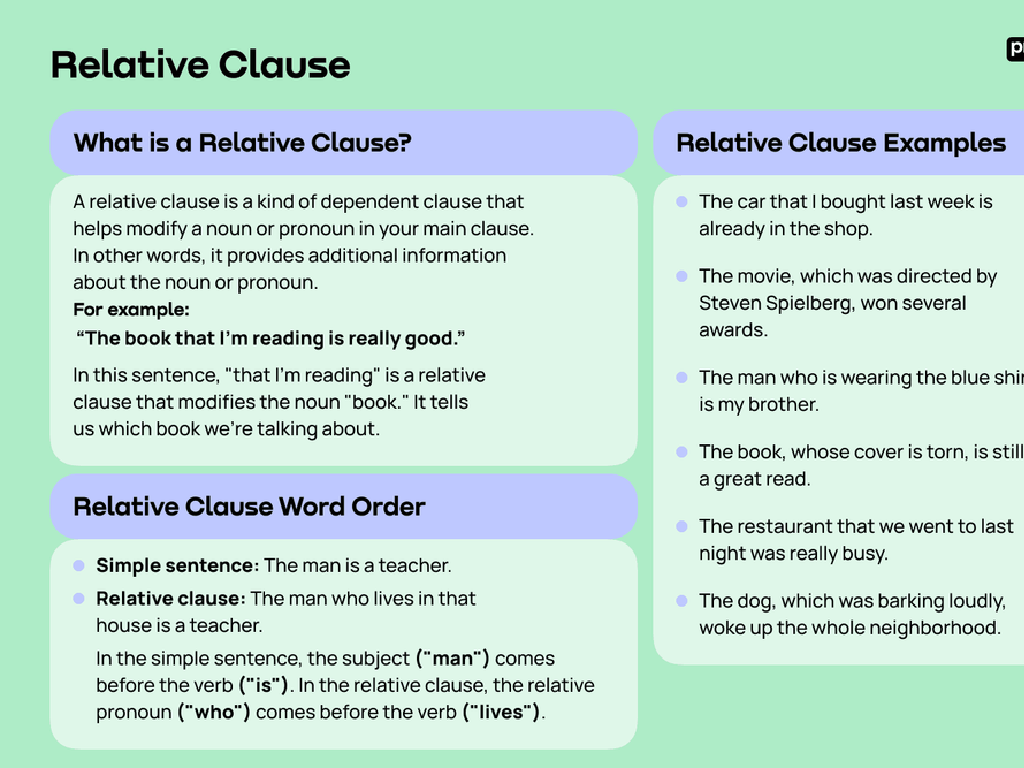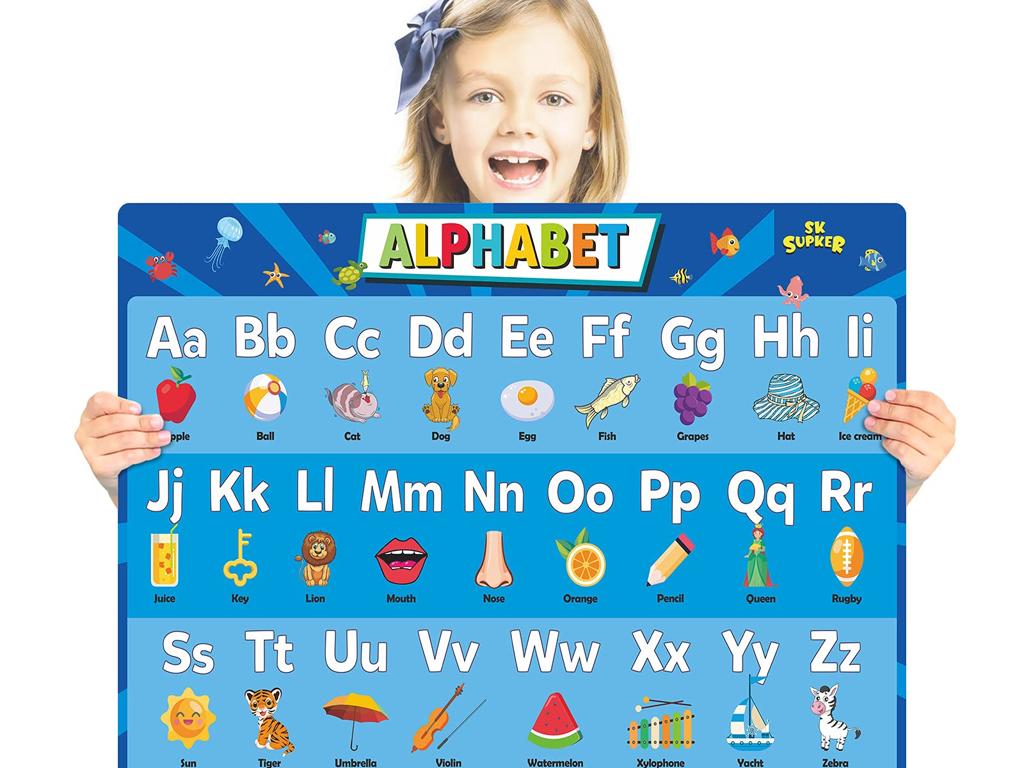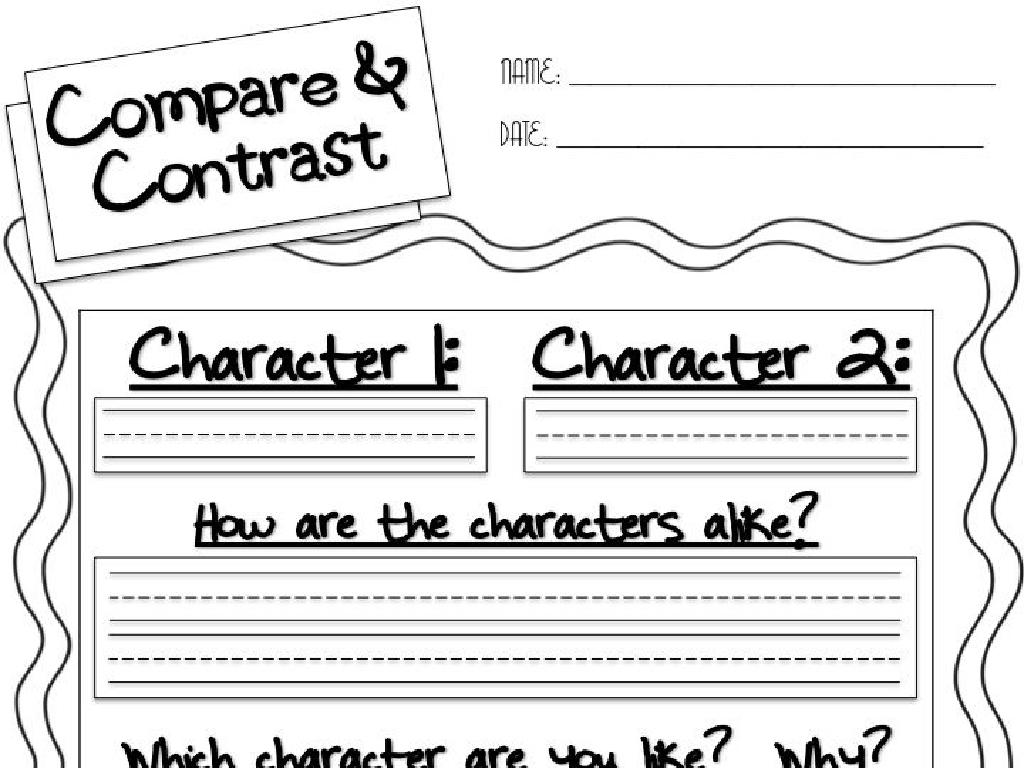Identify Adverbs
Subject: Language arts
Grade: Sixth grade
Topic: Adjectives And Adverbs
Please LOG IN to download the presentation. Access is available to registered users only.
View More Content
Identifying Adverbs in Sentences
– Adjectives vs. Adverbs
– Adjectives describe nouns, while adverbs modify verbs, adjectives, and other adverbs.
– Adverbs add ‘flavor’
– Adverbs describe how, when, where, and to what extent actions are performed.
– How to spot an adverb
– Look for words ending in -ly, and ask how? when? where?
– Practice identifying adverbs
– We’ll find adverbs in sample sentences together.
|
This slide introduces the concept of adverbs to the students, distinguishing them from adjectives. It’s crucial to emphasize that while adjectives provide more information about nouns, adverbs modify verbs, adjectives, and even other adverbs, often answering questions like how, when, and where. Many adverbs end in -ly, but not all, so students should also learn to recognize adverbs by the role they play in the sentence. During the class, engage students with examples and encourage them to practice by identifying adverbs in sentences, either from the board or their reading material. This will help solidify their understanding of how adverbs function to add detail and ‘flavor’ to language.
Understanding Adverbs
– Adverbs modify verbs, adjectives, and other adverbs
– For instance, ‘He ran quickly’ shows how he ran
– They answer ‘how’, ‘when’, ‘where’, ‘how much’, ‘how often’
– ‘When did he arrive?’ ‘He arrived early.’ ‘Where does she study?’ ‘She studies here.’
– Examples: ‘quickly’, ‘silently’, ‘well’, ‘very’, ‘often’
– ‘She sings very well.’ ‘He often reads books.’
|
This slide introduces the concept of adverbs to the students, explaining their role in a sentence. Adverbs are words that modify or describe verbs, adjectives, and even other adverbs, providing more detail. They can answer questions about the action or state of being, such as how it’s done (quickly), when it happens (now), where it occurs (here), to what extent (very), and how often (often). Use the examples to show how adverbs can change the meaning of a sentence and enhance description. Encourage students to think of adverbs they already know and use them in sentences. This will help them understand the practical use of adverbs in everyday language.
Exploring Adverbs in Sentences
– Finding adverbs in examples
– Look for words that describe how, when, or where actions happen.
– How adverbs modify verbs/adjectives
– Adverbs can change or enhance the meaning of the verb or adjective they modify.
– Discussing adverbs’ impact on meaning
– Each adverb adds detail, such as time, manner, degree, or frequency.
– Activity: Identify adverbs in sentences
|
This slide aims to help students identify and understand the role of adverbs in sentences. Begin by presenting sentences and guiding students to find adverbs, focusing on words that modify verbs and adjectives by indicating how, when, where, and to what extent actions occur. Discuss how adverbs can alter the meaning of a sentence by providing additional context or detail. Engage the class in an activity where they identify adverbs in provided sentences and discuss the nuances they add to the overall meaning. Encourage students to think critically about how the sentence changes with the inclusion of different adverbs. This exercise will enhance their comprehension and grammatical skills.
Exploring Types of Adverbs
– Adverbs of Manner: describe ‘how’
– Examples: ‘He spoke gently’, ‘She quickly agreed’
– Adverbs of Time: indicate ‘when’
– Examples: ‘We will meet later’, ‘Do it now’
– Adverbs of Place: specify ‘where’
– Examples: ‘Come here’, ‘They searched everywhere’
– Adverbs of Degree: show ‘to what extent’
– Examples: ‘I am very happy’, ‘She is quite sure’
|
This slide introduces students to the different types of adverbs and their functions in a sentence. Adverbs of Manner answer the question ‘how’ an action is performed, often ending in ‘-ly’. Adverbs of Time tell us ‘when’ something happens and can be specific times or general periods. Adverbs of Place point out ‘where’ an action takes place, and they can indicate direction, distance, or position. Adverbs of Degree express ‘to what extent’ an action is done or an adjective is applicable. Encourage students to come up with their own sentences using different adverbs for each category to reinforce their understanding.
Identifying Adverbs in Sentences
– Spotting adverbs in sentences
– Adverbs describe verbs, adjectives, or other adverbs and often answer questions like how, when, where, how much, and how often.
– Common ‘-ly’ adverb ending
– Many adverbs end in ‘-ly’ like ‘quickly’, ‘happily’, or ‘sadly’.
– Not all adverbs end in ‘-ly’
– Words like ‘very’, ‘quite’, and ‘almost’ are also adverbs without ‘-ly’.
– Practice identifying adverbs
– Find adverbs in a book or your writing and explain their role.
|
This slide introduces students to the concept of adverbs and how to identify them within sentences. Emphasize that while many adverbs end with the suffix ‘-ly’, there are exceptions. Provide examples of both types of adverbs and encourage students to think of additional examples. Instruct students to practice by finding adverbs in their reading material or by creating sentences that include adverbs. This will help them understand the role of adverbs in modifying verbs, adjectives, and other adverbs, and how they contribute to the richness of language.
Let’s Practice: Identifying Adverbs
– Find adverbs in sentences
– Look for words that describe verbs, adjectives, or other adverbs
– Discuss why they are adverbs
– Explain how adverbs modify and give more detail
– Share answers with the class
– Practice public speaking and listening skills
|
This slide is for a class activity focused on identifying adverbs. Students will practice finding adverbs within given sentences. They should look for words that modify verbs, adjectives, or other adverbs, typically ending in -ly. Encourage them to discuss the function of these adverbs: how they add detail, describe actions, or intensify adjectives. After identifying and discussing, students will share their findings with the class, which will help reinforce their understanding and improve their communication skills. For the teacher: Prepare sentences with clear adverbs, guide the discussion to ensure understanding, and facilitate sharing in a way that every student gets a chance to participate.
Adverbs vs. Adjectives
– Distinction between adverbs and adjectives
– Adjectives describe nouns
– Words like ‘quick’ and ‘brown’ describe the noun ‘fox’.
– Adverbs describe verbs, adjectives, adverbs
– Words like ‘quickly’ modify the verb ‘jumped’.
– Examples: ‘quick brown fox’ vs. ‘jumped quickly’
|
This slide aims to clarify the difference between adverbs and adjectives for the students. Adjectives are words that describe nouns, which are people, places, things, or ideas. Adverbs, on the other hand, are used to modify verbs, adjectives, or other adverbs, providing more information about how, when, where, or to what extent something happens. Use the example ‘The quick brown fox’ to show adjectives in action, describing the fox. Then, contrast it with ‘The fox jumped quickly’ to illustrate how ‘quickly’ is an adverb modifying the verb ‘jumped’. Encourage students to come up with their own sentences and identify the adjectives and adverbs within them.
Class Activity: Adverb Hunt
– Pair up and choose a book excerpt
– List all adverbs you find
– Explain adverbs’ role in sentences
– Describe how the adverb modifies a verb, adjective, or another adverb
– Present your adverb discoveries
|
This activity is designed to help students identify and understand the use of adverbs within the context of writing. By working in pairs, students will engage with the material in a collaborative and interactive way. Encourage them to choose excerpts from books they enjoy to maintain their interest. As they list the adverbs, prompt them to consider how each adverb is modifying the verb, adjective, or other adverbs in the sentence. This will deepen their understanding of the function of adverbs. When presenting, students should explain their findings, which will reinforce their learning and benefit their peers. Possible variations of the activity could include finding adverbs in song lyrics, movie scripts, or creating sentences with adverbs.
Wrapping Up: Adverbs & Homework Task
– Recap: Identifying adverbs
– Remember, adverbs describe verbs, adjectives, and other adverbs
– Homework: Craft 10 sentences
– Include adverbs that tell how, when, where, and to what extent
– Use a variety of adverbs
– Try to use adverbs that enhance your sentences creatively
– Share your work next class
|
As we conclude today’s lesson on adverbs, remind students of the key points on how to identify adverbs in sentences. For homework, they should write 10 original sentences, each incorporating a different adverb. Encourage them to use a mix of adverbs that describe how, when, where, and to what extent an action occurs. This will help reinforce their understanding of adverbs and how they function within a sentence. In the next class, students will have the opportunity to share their sentences, which will allow them to learn from each other’s examples and further solidify their grasp of the concept.






